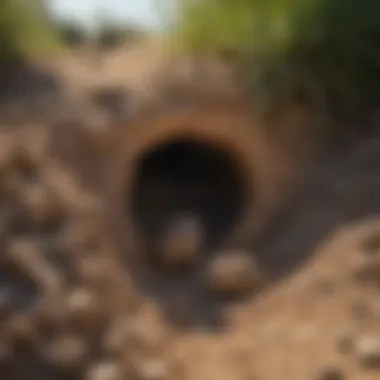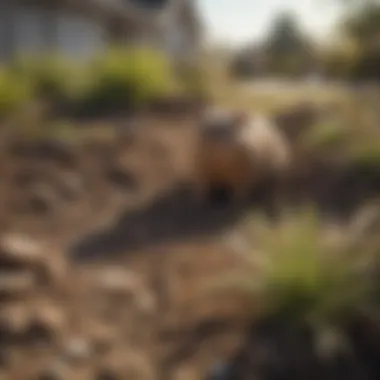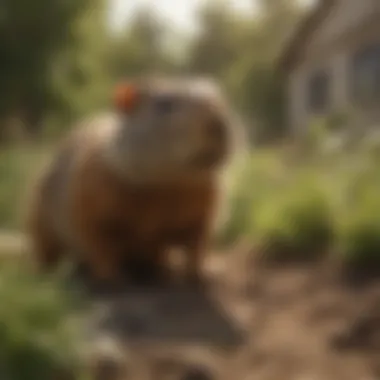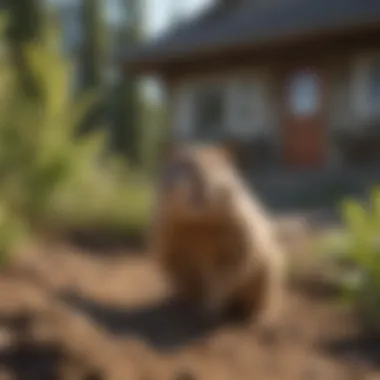Understanding Gophers Under Your House: Assessment and Action


Intro
Gophers can pose significant challenges for homeowners. Their burrowing activities not only disturb the landscape but can also threaten the structural integrity of buildings. Understanding these creatures is essential for effective management. This article aims to guide homeowners in identifying gophers, recognizing signs of infestation, and employing management strategies that maintain ecological balance.
Pest Identification
Identifying gophers is the first step in effective management. These rodents are typically about 6 to 10 inches long and have stocky bodies, short limbs, and large front teeth designed for burrowing.
Common Household Pests
Gophers are often confused with other rodents. Common household pests include:
- Mice: Smaller in size, with longer tails.
- Voles: Resemble gophers but have shorter tails and are more active in open areas.
- Squirrels: Larger, with bushy tails and more visible above ground.
Signs of Infestation
Recognizing signs of gopher activity is crucial. Homeowners should look for:
- Mounds of dirt: Gophers create distinctive fan-shaped mounds as they dig.
- Plant damage: Look for wilting or dead plants, especially near these mounds.
- Gnaw marks: Fresh gnaw marks on plants indicate their presence.
"Early detection of gophers can save your yard from significant damage and reduce the effort needed for control."
Prevention Methods
Prevention is key to avoiding gopher infestations. Implementing proper techniques can help deter these pests from taking residence under your home.
Environmental Modifications
Making changes in the environment can greatly affect gopher activity. Consider the following actions:
- Remove debris: Clear away piles of wood, rocks, or other materials that can serve as shelter.
- Alter landscaping: Use thicker plants that are less appealing to gophers.
Home Maintenance Tips
Ongoing maintenance around the home limits the chances of gopher intrusion. Keep the following in mind:
- Seal entry points: Inspect and seal any cracks or entryways in the foundation.
- Manage irrigation: Overwatering can attract gophers seeking moisture.
DIY Pest Control Solutions
When gophers invade, taking action can minimize their impact. Numerous DIY control methods are available for homeowners.
Natural Remedies
Consider natural approaches to deter gophers. These include:
- Castor oil: Spraying castor oil around the affected area may repel gophers.
- Garlic: The strong odor can discourage their presence.
DIY Traps and Barriers
Trapping gophers manually can be effective. Homeowners may use:
- Live traps: Capture and relocate gophers humanely.
- Barriers: Install underground fences of metal mesh to block potential digging.
In summary, understanding gophers under your house involves identifying them correctly, implementing preventive measures, and utilizing effective control solutions. By thoroughly assessing the situation and taking informed action, homeowners can maintain their properties and avoid further complications with these animals.
Prelude to Gophers
Understanding gophers is crucial for homeowners who may encounter these creatures beneath their homes. Their presence can lead to various challenges, including damage to landscaping, structural issues, and changes to local ecology. Recognizing the importance of this subject helps in devising proactive measures against potential infestation. Moreover, it paves the way for a balanced approach in managing their populations while considering their ecological roles.
Defining Gophers


Gophers are burrowing mammals that belong to the family Geomyidae. They are small, typically measuring between 5 to 14 inches in length. Known for their distinctive cheek pouches, gophers transport food and nesting material back to their burrows effectively. Their bodies are adapted to a life underground, featuring strong forelimbs capable of digging extensive tunnel systems.
Species Identification
In North America, several species of gophers can be found, including the Botta’s gopher and the plains pocket gopher. These species can often be identified by their fur coloration and size. For example, Botta’s gopher is usually brown or grayish, contrasting with the lighter-colored plains pocket gopher. Identification is essential for effective management, as different species may require different control strategies.
Gophers in Urban Environments
Gophers often adapt to urban settings where they can find abundant food sources and suitable nesting sites. Lawns, gardens, and flower beds provide a tempting feast for these animals, and as such, their populations can grow rapidly in residential areas. This presence can result in unsightly mounds of dirt and damage to roots of plants, leading to further complications for homeowners. Identifying the link between gopher activity and garden health is paramount for devising suitable management strategies.
Gopher Behavior and Ecology
Understanding gopher behavior and ecology is essential for homeowners dealing with these pests. Gophers, being primarily underground dwellers, have unique habits that can significantly affect their surroundings. Their actions, such as burrowing and feeding, have direct implications on landscaping and garden health. Grasping these aspects helps in crafting effective management strategies.
Burrowing Habits
Gophers are known for their extensive burrowing. They create complex tunnel systems that can stretch several feet below the ground. This activity is vital for their survival, as it provides shelter from predators and extreme weather. Moreover, these tunnels aerate the soil, impacting vegetation in both positive and negative ways. Homeowners may notice small mounds of earth on the surface, which are indicators of gopher activity.
Several factors influence burrowing behavior:
- Soil Type: Gophers prefer soft soils that are easier to dig through.
- Moisture Levels: They tend to dig deeper during dry spells to reach moister soils.
- Food Availability: An abundance of roots and shrubs in the area encourages gophers to establish burrows nearby.
Being aware of these factors can assist in preventing gophers from taking residence under structures.
Feeding Patterns
Gophers are primarily herbivorous, feeding on a range of plant materials. Their diet includes:
- Roots
- Tubers
- Grasses
- Various vegetable plants
This feeding behavior is focused on root systems, which can severely damage plants and crops. The extent of their feeding can lead to significant losses in gardens and lawns.
Interestingly, gophers also store food in their burrows. They often hoard roots and tubers for later consumption, providing a sustainable food source. Recognizing patterns in their feeding can help owners take proactive measures, like planting gopher-resistant plants.
Reproductive Behavior
Gopher reproduction is typically seasonal, with most breeding occurring in spring. A female gopher can have multiple litters, each consisting of 3 to 5 young. This rapid reproduction can lead to swift increases in local populations, complicating management efforts.
Gophers exhibit some territorial behaviors. Males may defend their burrow areas to secure resources. Understanding these reproductive habits is critical in planning control methods. Population control measures taken during peak breeding seasons tend to be more effective.
Indicators of Gopher Presence
Understanding the indicators of gopher presence is crucial for homeowners aiming to protect their property. Gophers can significantly affect the landscape and structural integrity of a home. Recognizing signs early can enable effective control and mitigation strategies. This section will help in identifying the signs that confirm a gopher infestation, and assessing the damage they may cause.
Signs of Gopher Activity
Detecting gopher activity involves looking for specific signs in your yard or garden. Here are some indicators that you may notice:
- Mounds of Soil: One of the most noticeable signs is the presence of large mounds of soil, measuring about ten to twelve inches in diameter. These mounds are typically formed as gophers push the dirt to the surface while burrowing.
- Surface Tunnels: If you observe raised earth forming linear paths across your lawn or garden, this could indicate that gophers are active beneath. These tunnels provide gophers easy access to their food sources.
- Missing Vegetation: You may notice that some plants, particularly roots and bulbs, seem to disappear. Gophers often consume plant roots, which can result in wilting or dead plants in affected areas.
- Droppings: Small, cylindrical droppings may be visible near mounds or tunnels, indicating gopher presence.
If you notice any of these signs, it is important to take action quickly. Early detection can minimize the damage these pests may cause to your landscaping and ensure that effective management strategies can be implemented.
Damage Assessment
Assessing the damage caused by gophers is essential for determining the appropriate course of action. Their burrowing can lead to various damages, including:
- Soil Erosion: Their tunneling can destabilize soil, leading to erosion. This may lead to shifts in the ground that could impact foundations and structures.
- Plant Loss: Gophers are known for their herbivorous diet, which primarily consists of roots and tubers. Loss of treasured plants can be both disappointing and financially burdensome.
- Irrigation Issues: Underground tunnels can interfere with irrigation systems, resulting in water leaks or inefficient watering. This can create patches of lawn that are either too dry or waterlogged.
- Increased Pest Activity: The disruption of soil and plant life can attract other pests, complicating the original issue.
"Identifying signs of activity and assessing damage quickly can save homeowners from more extensive repairs later."
To conduct an effective damage assessment, walk through your property and document any signs of gopher activity. Take photographs and note the extent of damage to plants and landscaping features. This record will aid in devising a comprehensive management plan.


Environmental Impact of Gophers
The ecological role of gophers may not be the first thought for many homeowners. However, their presence under residential structures can significantly influence local ecosystems. Understanding the environmental impact of gophers provides insight into the delicate balance they maintain within soil health and overall landscaping. It is essential to assess both the benefits and drawbacks of gopher activity to effectively manage their populations.
Soil Aeration Benefits
Gophers contribute positively to soil health through their natural burrowing habits. As they dig tunnels, gophers create air pockets in the soil, allowing better aeration which benefits plant roots. This aeration helps in:
- Improved Nutrient Absorption: Nutrients in the soil become more accessible to plants due to increased airflow.
- Enhanced Water Drainage: Their burrows facilitate rainwater infiltration, reducing runoff and potential erosion.
- Microbial Activity: Burrowing disrupts compact soil layers, fostering microbial growth crucial for soil fertility.
These activities help in maintaining a balanced ecosystem. While homeowners may view gopher tunnels as unsightly, the soil structure they promote can lead to healthier gardens over time.
Negative Effects on Landscaping
On the other hand, the activities of gophers can lead to notable disturbances in residential landscapes. The same tunnels that aid in aeration can cause serious issues:
- Plant Damage: Gopher feeding habits might uproot or destroy flowers, shrubs, and young trees, leaving unsightly patches in gardens.
- Ground Instability: Extensive burrowing can create soft spots in the ground, which may pose risks to structures like patios and driveways.
- Aesthetic Concerns: Tunneling leads to a messy yard, detracting from the visual appeal of landscaping efforts.
Managing these negative impacts requires a thoughtful approach. Homeowners should be mindful of the delicate balance between their beneficial contributions to soil health and the potential harm they can cause to gardens and landscapes.
In assessing gopher presence, it is vital to approach the situation holistically, weighing the benefits of their soil aeration against the management of potential damage to landscaping.
Managing Gopher Populations
Managing gopher populations is crucial for maintaining a harmonious relationship between homeowners and their environment. As gophers dig and burrow, they can disrupt gardens, lawns, and foundations. Understanding how to manage their populations effectively can prevent extensive damage and costly repairs. This section elaborates on essential methods for managing gophers, with a focus on preventive measures, humane control methods, and chemical and mechanical solutions. Each approach has its own advantages and limitations, and homeowners must consider their specific situations in order to select the most appropriate solution.
Preventive Measures
Preventive measures form the first line of defense against gopher invasions. Simple steps can significantly reduce the likelihood of gophers making a home under your yard. Key strategies include:
- Soil Barriers: Installing underground barriers made of wire mesh can deter gophers from entering specific areas. The mesh should be buried at least 12 inches deep to be effective.
- Garden Design: Selecting plants that are less appealing to gophers can decrease the chance of infestation. Native plants or those with strong scents may deter these pests.
- Maintenance of Landscapes: Keeping a tidy garden with trimmed bushes and short grass can make areas less inviting to gophers. Regular upkeep also allows for easier spotting of new burrows.
Implementing these preventive measures can save time, effort, and financial resources while promoting a more sustainable landscape.
Humane Control Methods
Humane control methods focus on managing gopher populations without causing harm to the animals. This approach aligns with ethical considerations while still protecting property. Common humane solutions include:
- Live Trapping: Using live traps allows homeowners to capture gophers without harming them. Once trapped, gophers can be relocated to a safe distance.
- Natural Repellents: Using natural substances, such as castor oil or cayenne pepper, can deter gophers from invading gardens and landscapes. Applying these substances around burrow entrances may encourage them to move elsewhere.
- Encouraging Natural Predators: Attracting birds of prey, such as hawks or owls, can provide a natural control method. Installing perches or encouraging habitats for these birds can help keep gopher populations in check.
These humane methods effectively manage gopher populations while respecting their role in the ecosystem.
Chemical and Mechanical Solutions
In cases where gopher populations become unmanageable, chemical and mechanical solutions may be necessary. These methods offer more immediate results but require careful application to minimize impact on the environment. Options include:
- Poison Baits: Professionally formulated poison baits can effectively reduce gopher populations. Homeowners must follow specific instructions and local regulations when using these products to ensure safety for other wildlife and pets.
- Mechanical Traps: Devices such as gopher traps can capture gophers quickly. These traps are often favored for their efficiency and long-term effectiveness when fully utilized.
- Gassing: Using gas as a means of extermination can be effective, but it comes with significant risks. It is advisable to consult professionals before considering this method.
Understanding the diverse methods for managing gopher populations empowers homeowners to make informed decisions. Each method carries its own set of benefits and challenges, necessitating careful consideration of the particular situation.
"Effective management of gopher populations not only protects your property, but also fosters a balanced coexistence with these animals."
By addressing these considerations, homeowners can protect their spaces while maintaining respect for the natural world.
Legal and Ethical Considerations
Understanding the legal and ethical landscape surrounding gopher management is essential for homeowners and pest control professionals alike. Proper adherence to local regulations not only protects the homeowner’s interests but also ensures compliance with state and federal laws. Furthermore, engaging in ethical pest management practices reflects a commitment to ecological balance and animal welfare. Thus, any action taken in managing gopher populations should carefully evaluate the impact on the environment and the local ecosystem.
Local Regulations on Pest Control
Local regulations regarding pest control are designed to protect public safety and the environment. Homeowners should be aware of these rules to avoid potential fines or legal issues. Here are some important points to consider:


- Permits: In some areas, permits may be required for particular pest control measures. Before starting any eradication efforts, check with local authorities to see what is necessary.
- Chemical Use Restrictions: Certain chemicals are prohibitive in specific regions due to their potential to harm other wildlife or the environment. Familiarize yourself with these restrictions to ensure compliance.
- Reporting Requirements: Some jurisdictions require residents to report gopher infestations, especially in agricultural areas. This helps in assessing pest management efficacy and determining necessary interventions.
- Humane Treatment Protocols: Many local laws highlight the need for humane treatment of pests. This applies not only during removal but also during any control measures taken to mitigate populations.
Applying these regulations enhances the management approach and ensures that the practices adhered to are socially responsible. For more detail on regulations related to pest control, consider checking resources like Wikipedia's Pest Control page for greater insights.
Ethics of Gopher Management
The ethics of gopher management pertain to the responsibility that individuals and companies uphold in mitigating pest issues. Effective gopher management should take an ethical stance, prioritizing humane methods wherever possible, and ensuring ecological sustainability. Key ethical principles include:
- Humane Treatment: The approach adopted should minimize suffering for the gophers. Methods that cause unnecessary pain should be avoided. For instance, traps that ensure a quick death or relocation options are preferable.
- Ecosystem Balance: Gophers play a role in the ecosystem; thus, completely eradicating them may lead to unforeseen consequences. It is vital to assess how their absence could affect the environment and other wildlife.
- Community Consideration: Engaging with neighbors about gopher issues fosters cooperation in pest management efforts. A community-focused approach can lead to better sustainable practices, which benefit all parties involved.
"Ethical pest management is not just about following regulations; it's about building a sustainable relationship with our environment."
By integrating these ethical considerations into gopher management plans, homeowners can ensure that their actions are justifiable and contribute positively to their surroundings. The focus on humane practices and respect for local wildlife enhances the overall effect of pest control initiatives.
Professional Pest Control Services
Professional pest control services play a critical role in effectively managing gopher populations, especially when these rodents pose significant risks to residential properties. Homeowners often face challenges that extend beyond mere annoyance; gophers can cause extensive damage through their burrowing activities. Utilizing specialized expertise and advanced tools, professional services ensure a comprehensive approach to gopher management, incorporating prevention, control, and sustainable practices.
When to Seek Professional Help
Recognizing the right moment to engage professional help can be crucial in managing a gopher issue. Here are factors indicating that assistance should be sought:
- Persistent Activity: If signs of gopher activity such as mounds, burrows, or damage to plants remain after applying DIY methods, professional intervention is necessary.
- Extent of Damage: When damage escalates to structural concerns like foundation erosion or compromised soil stability, immediate action is required.
- Scale of Infestation: Larger infestations can overwhelm a homeowner's approach. Professionals have the tools and strategies to handle significant populations effectively.
- Time Constraints: Busy schedules may not allow for constant monitoring or intervention. Professionals can provide regular maintenance to keep gopher populations under control.
- Safety Concerns: Professionals can assess and address safety risks associated with burrowing activities, particularly in areas with children or pets.
Choosing a Pest Control Service
Selecting the right pest control service is crucial for effective gopher management. Here are key considerations:
- Experience and Expertise: Look for companies that specialize in rodent control, particularly gophers. They should have a proven track record and knowledge of local gopher species.
- Methods and Practices: Inquire about the methods they use. Opt for pest control services that prioritize humane and environmentally friendly approaches.
- Reputation and Reviews: Research online reviews and testimonials. Feedback from previously served customers can provide insight into a company's reliability and effectiveness.
- Licensing and Certification: Ensure the company carries the necessary licenses and certifications to operate legally in your area.
- Transparent Pricing: Look for service providers that offer clear and detailed estimates. Understanding costs upfront can prevent unpleasant surprises.
- Follow-Up Services: Effective gopher management often requires follow-up visits. Ensure the selected service offers ongoing support following initial treatment.
Engaging with professional pest control services can provide the necessary expertise to assess the gopher presence effectively and implement proper management strategies. It is a prudent decision that saves time, resources, and potential property damage.
Case Studies: Gopher Management Success Stories
Exploring case studies on gopher management offers invaluable lessons and insights. These stories provide real-world examples of effective strategies, revealing practical applications and outcomes. They illustrate how different approaches can lead to varied results, emphasizing the importance of tailored solutions in gopher management. By analyzing these cases, homeowners can understand possible pitfalls and advantages associated with different methods.
Residential Case Study
In a suburb of San Diego, a homeowner faced a significant gopher problem that threatened her garden and landscaping. After noticing the distinct mound soil formations in her yard, she recognized the necessity for action. Rather than turning to chemical solutions immediately, she opted for a more integrated approach. The first step included consulting with a local pest control expert who highlighted the behavior patterns of gophers.
Her strategy involved a combination of trapping and preventive barriers. She installed underground wire mesh around her garden beds to deter gophers from accessing plants. Simultaneously, she set traps in areas of high activity to decrease the local population. Within a few weeks, the gopher activity noticeably decreased, verifying the effectiveness of the combined methods. Through this experience, the homeowner learned the importance of adapting her approach rather than relying solely on one method.
Community Impact Project
In an urban area of Portland, a community initiative was launched to address a widespread gopher issue affecting several neighborhoods. The project aimed to manage gopher populations while educating residents about coexisting with these creatures. The responsible committee collaborated with local wildlife experts to develop eco-friendly strategies that would minimize damage to both homes and gardens.
The project included workshops for homeowners on identifying signs of gophers and understanding gopher behavior. Community members were encouraged to use humane traps and alternative preventive measures instead of harmful chemicals. This peer-driven initiative fostered a sense of community responsibility and engagement. As a result, gopher populations gradually decreased, and residents reported improved attitudes toward wildlife management, appreciating the value of ecological balance.
"Community efforts not only address a pest problem but also strengthen connections among neighbors, enabling a shared understanding of local wildlife."
By highlighting the successes in both the residential case and the community project, it becomes clear that education and tailored strategies are crucial in managing gopher populations effectively. These case studies serve as guides for other homeowners facing similar issues, emphasizing that thoughtful and informed approaches lead to meaningful solutions.
End
In summary, addressing gopher issues is critical for homeowners who want to maintain a healthy and attractive landscape. Gophers, while sometimes perceived as just a nuisance, have a significant impact on the environment and the safety of residential structures. Understanding their behaviors and the consequences of their presence is the first step in effective management.
Summary of Key Points
- Awareness of Gopher Presence: Recognizing the signs of gopher activity is key to timely intervention, reducing potential damage.
- Environmental Impact: Gophers contribute positively through soil aeration, but their burrowing can also disrupt landscaping, affecting aesthetic appeal and plant health.
- Management Strategies: Homeowners have various options for managing gopher populations, ranging from preventative measures to humane control methods.
- Legal and Ethical Considerations: It's essential to be aware of local regulations and ethical practices surrounding pest control to ensure compliance and humane treatment of wildlife.
- Professional Help: Knowing when to engage professional pest control services can save time and resources while providing effective solutions.
Future Considerations in Gopher Management
As gopher populations and their habitats evolve, future management strategies must focus on sustainability and environmental balance. Here are some considerations:
- Research in Ecology: Continued studies on gopher behaviors and their ecosystems will provide insights that can enhance control methods.
- Innovative Control Methods: Advances in technology may yield more effective and humane control solutions that respect wildlife.
- Community Engagement: Homeowners should participate in local initiatives to manage gopher populations collectively, fostering education and awareness.
- Monitoring Changes: Keeping an eye on changes in the environment that may affect gopher behavior can lead to more proactive management strategies.
Addressing the presence of gophers under residential structures requires a balanced approach that considers both the ecological role of these creatures and the needs of homeowners. By staying informed and applying well-thought-out management practices, it's possible to deal effectively with gophers while maintaining the health of your garden and the integrity of your home.















